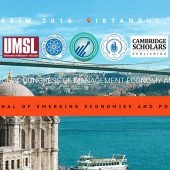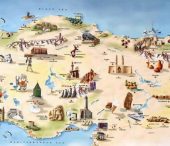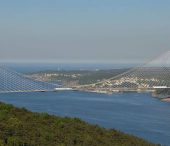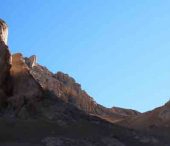The İstanbul Archaeological Museums, a museum affiliated to the Ministry of Culture and Tourism, is located in İstanbul's Sultanahmet neighborhood, on the Osman Hamdi Bey slope connecting the Gülhane Park with the Topkapı Palace. Its name is plural, since there are three different museums under the same administration: The Archaeological Museum, the Ancient Orient Museum (Eski Şark Eserleri Müzesi) and Tiled Kiosk Museum (Çinili Köşk Müzesi).
During an İstanbul Archaeological Museums tour, it is possible to visit the extraordinarily beautiful garden of the museum and the three different buildings inside this garden.
The İstanbul Archaeological Museums, which is housing various artifacts from civilizations that had left their traces to different periods of the history, is one of the 10 most important world-class museums designed and used as a museum building. Additionally, it is the first institution in Turkey arranged as a museum. Besides its spectacular collections, the architectural aspects of its buildings and its garden are of historical and natural importance.
The İstanbul Archaeological Museums is welcoming all visitors who want to make a journey in the corridors of the history and to trace the remains of ancient civilizations.
The İstanbul Archaeological Museums, inherited by the Republic of Turkey from the Ottoman Empire, is hosting the outcomes of the first activities in the field of museum works. In fact, in the Ottoman era, traces of the interest in collecting historical artifacts goes back to the era of Sultan Mehmed II the Conqueror.
However, the first regular museum works appeared when the İstanbul Archaeological Museums was founded in 1869 as the Imperial Museum (Müze-i Hümayun). The Imperial Museum, which consisted of archaeological artifacts collected until then and exhibited in the Hagia Irene (Aya İrini) church, laid the foundations of the İstanbul Archaeological Museums. Saffet Pasha, then Minister of Education, was closely interested in the museum and acted personally to expand its collections. Additionally, he made Edward Goold, a teacher of English origin in the Galatasaray High School (Galatasaray Lisesi), to be appointed as the director of the museum.
After being abolished for a while, the Imperial Museum was established again in 1872 by the Minister of Education Ahmed Vefik Pasha, who appointed the German Dr. Phillip Anton Dethier as the director. As a result of the works of Dr. Dethier, the room in the Hagia Irene church became insufficient and the construction of a new building came to the agenda. Due to financial constraints, a new building could not be constructed, but the Tiled Kiosk (Çinili Köşk), built in the era of Sultan Mehmed II the Conqueror, was transformed into a museum. The Tiled Kiosk, which is currently operated by the Istanbul Archaeological Museums, was restored and opened in 1880.
The appointment of Osman Hamdi Bey, the son of Grand Vizier Edhem Pasha, as the director of the museum in 1881 marked a new epoch in the history of Turkish museums. Osman Hamdi Bey led excavations in Mount Nemrut, Myrina, Kymi and other Aeolian Necropoles and in the Lagina Hekate Sanctuary, and collected the artifacts from these sites in the museum. In 1887-1888, he found the Royal Necropolis in Sidon, Lebanon, and he returned with many sarcophagi, including the famous Sarcophagus of Alexander the Great, to İstanbul.
The oldest building in the complex of İstanbul Archaeological Museums is the Tiled Kiosk. The Tiled Kiosk Museum, where samples of Turkish tile and ceramic works are exhibited today, is the oldest civilian architectural work in İstanbul commissioned by Sultan Mehmed II the Conqueror. The influence of Seljuk architecture is apparent. According to the tile inscription above the gate, the pavilion was built in 1472 AD, but its architect is unknown.
The two other buildings that were constructed later are close to the Tiled Kiosk. One of them is the building constructed as the first Academy of Fine Arts in the Ottoman Empire and re-designed later as the Ancient Orient Museum.
The building, which is hosting the Ancient Orient Collection today, was constructed in 1883 by the order of Osman Hamdi Bey as the School of Fine Arts (Sanayi-i Nefise Mektebi), i.e. the Academy of Fine Arts. This was the first school of fine arts opened in the Ottoman Empire and it laid the foundations of today's Mimar Sinan University of Fine Arts. The architect of the building was Alexander Vallaury, who built later the classical building of the İstanbul Archaeological Museums. In 1917, the academy moved to another building in the Cağaloğlu neighborhood and the building was assigned to the directorate of museums.
Halil Edhem Bey, the then director of the museum, thought that it was more appropriate to exhibit the artifacts from the ancient cultures of the Near Eastern countries and Greek, Roman and Byzantine artifacts separately, and this building was arranged as the Ancient Orient Museum. The German expert Eckhard Unger, who was invited to lead this transformation, worked in İstanbul in 1917-1919 and 1932-1933, gave the final shape to the museum and made several publications on the artifacts.
The museum building was emptied during the World War II for purposes of defense and re-organized later by Osman Sümer in compliance with the principles of Unger. After an extensive restructuring that started in 1963, the museum was re-opened in 1974. The Ancient Orient Museum, which underwent maintenance and repairs in 1999-2000, obtained its current shape on September 8, 2000.
On the other hand, the Archaeological Museum is one of the few buildings in the world constructed as a museum building.
The Archaeological Museum, one of the most beautiful and glorious examples of the neo-classical architecture in İstanbul, has a very spectacular architecture especially due to its gorgeous façade. With the two entrances on the long façade, which are reached through wide stairs, and each of which is decorated with four columns and a pediment, it appears like a temple. The kufic inscription on the pediment in Ottoman Turkish says 'Asar-ı Atika Müzesi' (Ancient Artifacts Museum). The tughra (calligraphic seal) above this script belongs to the Ottoman Sultan Abdülhamid II, who ordered the construction of the Old Building.
A new museum building was needed in order to display the glorious artifacts such as the Alexander Sarcophagus, the Sarcophagus of the Crying Women, the Lycian Sarcophagus and the Sarcophagus of Tabnit brought to İstanbul after the Royal Necropolis excavations in Sidon, Lebanon led by Osman Hamdi Bey in 1887 and 1888. The İstanbul Archaeological Museum, which was built against the Tiled Kiosk by the then famous architect Alexander Vallaury on the request of Osman Hamdi Bey, was opened to visits on June 13, 1891. This day is still celebrated as the Museum Day in our country.
Today's main museum building took its final shape after the addition of the northern and the southern wings in 1903 and 1907 respectively.
Due to the need for new exhibition halls, a new building adjacent to the southeastern side of the main museum building was constructed between 1969 and 1983 and this section was named the Additional Building (new building).
Source: www.istanbularkeoloji.gov.tr










